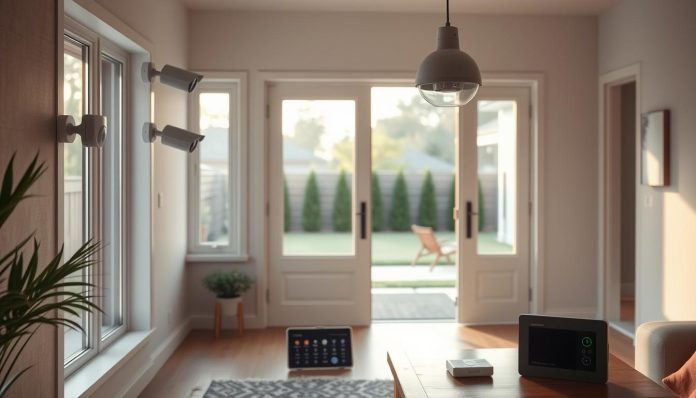Looking for a smart way to protect your house without long contracts? You’ll compare leading options that let you avoid ongoing bills while keeping sensible protection. This guide focuses on clear, practical choices from brands like SimpliSafe, Abode, Ring, Arlo, Reolink, Eufy, and ADT Self Setup.
We tested devices in a two-story, 2,200-square-foot home and scored each by affordability, equipment quality, and monitoring options. You’ll see plans that range from gear-only setups to month-to-month professional monitoring from about $21.99 to $79.99 per month. Equipment prices start near $159 to $250 depending on the package.
Expect simple comparisons of self-monitoring vs. professional monitoring, plus notes on local storage, smart‑home integration, and when temporary paid help makes sense. You’ll get a shortlist that helps you move from research to checkout with confidence.
Why You Want a Home Security System Without Monthly Fees in the United States
Many U.S. households now favor systems that avoid ongoing monthly charges while still offering core protection. Choosing gear you own gives you cost control and freedom to change providers without penalties.
Professional monitoring is useful in emergencies, but self‑monitoring beats having no coverage at all. Modern apps send instant alerts, and sirens rated around 85–110 dB deter intruders even when you choose not to pay monthly monitoring.
You can add paid monitoring only when you travel or need extra reassurance. That month‑to‑month flexibility prevents long contracts and early termination fees. It also makes upgrades and brand switches simple.
- You keep core protections like entry sensors and motion detection without ongoing charges.
- Local storage options cut cloud costs and give you privacy control.
- Focus coverage on doors, windows, and key rooms to maximize value for apartments or houses.
Bottom line: A no‑contract approach helps you protect what matters while staying financially flexible and ready to add professional monitoring when you need it most.
Editor’s Top Picks at a Glance for No-Subscription Security
Here’s a compact shortlist you can scan fast. It highlights flexibility, smart‑home integration, and camera‑first options so you can shortlist gear that fits your budget and tech needs.
Most Flexible: SimpliSafe (SecureScore 9.2/10)
SimpliSafe scored 9.2/10 for fast feature switching and month‑to‑month monitoring. Packages start around $250 and paid monitoring begins at $21.99 per month. You can scale sensors or add monitoring only when you travel.
Smart‑Home Feature Leader: Abode (SecureScore 8.0/10)
Abode shines for smart integrations. It supports Apple HomeKit, Alexa, Google, Zigbee, and Z‑Wave. Basic starter kits commonly run $159–$179, making it a strong pick if you want deep automations.
Camera‑First Choices: Ring, Arlo, Reolink, Eufy
Ring Alarm (SecureScore 8.2/10) offers the widest camera and doorbell lineup, though recording often needs a plan. Arlo focuses on 2K/4K quality and an All‑in‑One Sensor. Reolink pushes local storage and hub options, while Eufy delivers on‑device detection and affordable gear.
- Quick guidance: start small — doorbell or hub kit — then expand.
- Use the quick picks to compare prices and to view packages or to view packages on retailer pages.
- If you shop online, check bundles on view amazon for deals that lower upfront cost.
These top picks help you vet the best security systems and narrow down which kit suits your layout and budget.
Best Home Security Systems with No Subscription Fees
Owning your gear lets you choose when to pay for extra services, like cloud storage or professional monitoring. Many major brands let you arm, disarm, and view live video without ongoing charges. That free baseline is often enough for everyday protection.
What “no subscription” actually covers
No subscription usually means app alerts, remote arming/disarming, and live streams are included. Brands such as SimpliSafe, Abode, Ring, and ADT Self Setup all offer those self-monitoring basics.
Recording is different: cloud storage often costs extra, while Reolink and Eufy emphasize local storage that avoids monthly cloud fees. Think of alarm monitoring and video storage as separate services.
How to toggle contract-free monitoring
You can enable professional monitoring month-to-month on many platforms. That makes it simple to add paid monitoring for a trip or a local crime uptick, then cancel when you return.
- Self-monitoring plan: saves money by sending instant app notifications you handle yourself.
- Professional monitoring: lets agents verify alarms and dispatch first responders when needed.
- Use local storage to skip cloud storage costs, or buy short cloud plans for long event history and smarter detection.
Start with a self-monitoring setup to save today, then add professional monitoring when your travel schedule or risk tolerance changes. That flexible approach keeps your security system useful and cost-effective.
SimpliSafe: Best DIY No-Contract System with Optional Monitoring
For renters and owners who prefer hands-on setup, SimpliSafe balances easy installation and optional paid monitoring so you control costs and coverage. Its SecureScore is 9.2/10, and starter packages begin near $250.
Key strengths: Intruder Intervention lets agents speak through your Wireless Indoor Camera to deter intruders quickly. Active Guard expands that capability outdoors, adding overnight patrols or full 24/7 coverage on higher tiers.
- You can build a kit around entry sensors, a keypad, and cameras, then expand without contracts.
- DIY installation is simple: peel-and-stick sensors and a modern base station speed setup.
- Self-monitoring is free, or you can add a monitoring plan that fits short trips or local alerts.
| Tier | Monthly Price | Key Add-on | Coverage Hours |
|---|---|---|---|
| Standard | $21.99 per month | Basic alarm monitoring | 24/7 |
| Core | $31.99 per month | Video verification, Intruder Intervention | 24/7 |
| Pro | $49.99 per month | Active Guard (overnight) | 8 pm–6 am |
| Pro Plus | $79.99 per month | Full Active Guard outdoor patrols | 24/7 |
When to self-monitor vs upgrade: Stick to self-monitoring for everyday needs and rely on app alerts and live views from your security cameras. If you travel or the neighborhood shows a rise in incidents, add a tier for a month and then switch back. Plan changes are contract-free, though subscriptions are non-refundable mid-cycle.
Want to price gear for your layout? Click to view packages and pick the right mix of sensors, cameras, and monitoring options for your home security system.
Abode: Best for Smart Home Features Without a Subscription
Abode blends a broad device ecosystem and DIY setup so you can tailor automations without extra monthlies. If you already own smart lights or locks, Abode lets you weave them into routines that save time and boost safety.
The platform supports apple homekit, Alexa, google home, Zigbee, and Z‑Wave, giving wide compatibility for third‑party gear. The Iota hub combines an HD camera, motion sensor, siren, and smart hub in one unit — ideal for small apartments or single rooms.
Abode’s free tier covers app control and integrations. The Standard plan unlocks CUE home automation routines. Pro adds professional monitoring and cellular backup for $24.99 per month to keep signals online during outages.
- You can connect many devices and build rules like “arm at bedtime and turn lights off.”
- Starter kits run around $159–$179, making this an affordable equipment entry point.
- Expand over time: swap or add sensors without replacing your core hub.
| Option | Includes | Typical Cost |
|---|---|---|
| Iota | Camera, motion, siren, hub | $159–$179 (kit) |
| Standard | CUE automations | Monthly plan (varies) |
| Pro | 24/7 monitoring, cellular backup | $24.99/mo |
Bottom line: If you want strong smart home features and flexible automation in a DIY package, Abode gives you deep integrations and clear upgrade paths. You can view packages to compare the Iota, Smart Hub, and Security Hub and pick the right home security system for your space.
Ring Alarm: Best Selection of Cameras with Flexible DIY
If you care about video coverage, ring alarm gives you many camera types that fill different sightlines. You can start at a porch doorbell and expand to floodlight cams for yards.
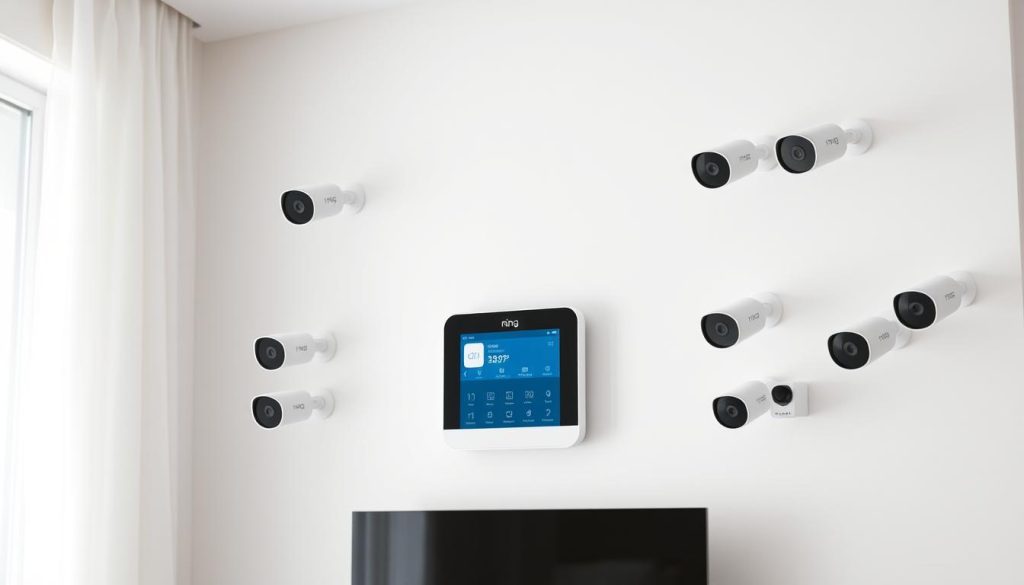
The lineup includes Indoor Cam, Spotlight Cam, Floodlight Cam, and video doorbells that start near $49.99. Self-monitoring stays free for live view and instant alerts, so you get basic protection without extra charges.
Recording requires a plan that adds cloud storage billed per month, but you can begin free and upgrade later. Ring Alarm starter kits cost about $199–$600 and include a practice mode that helps new users learn the app and zones.
- Quick perks: wide device choice, Alexa integration, and deterrent lights/sirens on spotlight and floodlight cams.
- DIY setup usually takes about 30 minutes and is guided in the app.
- You can shop bundles on view amazon for fast delivery and deals.
| Device Type | Starts At | Self-Monitoring | Recording Cost |
|---|---|---|---|
| Video Doorbell | $49.99 | Live view, alerts | $3–$10 per month |
| Spotlight Cam | $129.99 | Live view, motion alerts | $3–$10 per month |
| Floodlight Cam | $199.99 | Light, siren, alerts | $3–$10 per month |
| Ring Alarm Kit | $199–$600 | Hub, sensors, app | Optional plan per month |
Tip: If you want long event history, add a plan later. Check amazon links to compare current prices and build the security system bundle that fits your needs.
ADT Self Setup: Trusted Monitoring with Contract-Free Bundles
ADT Self Setup pairs DIY gear and app control with ADT’s SMART Monitoring for fast, reliable alerts. You can buy starter bundles near $269 and install them yourself while keeping access to ADT’s escalation tools.
SMART Monitoring sends text alerts in about 10 seconds and escalates to a call or dispatch if you don’t respond. That text-first flow often connects to police faster than older voice-only methods.
Google Nest cameras add facial recognition so you see who triggered an event, not just motion. Camera support and cloud storage are part of the top monitoring plan, which runs $39.99 per month.
- Contract-free bundles: get ADT’s trusted professional monitoring service without long-term ties.
- Reliable hub features: cellular backup and battery support keep your signals active during outages.
- Scalable: start small, add sensors and cameras, and change your monitoring plan as needs shift.
| Item | Typical Cost | Notes |
|---|---|---|
| Starter bundle | $269 (approx.) | DIY install, hub included |
| Top monitoring plan | $39.99/mo | Video verification, cloud storage, facial recognition |
| Hub features | Included | Cellular backup, battery support |
Tip: If you value quick text workflows and verified video when needed, ADT Self Setup is a strong pick that fits google home and other ecosystems. Click to view packages and compare whether you need camera support at launch.
Arlo, Reolink, and Eufy: No-Fee Camera Leaders for Self-Monitoring
These three camera makers give you clear choices for a self-monitoring plan that keeps monthly costs low. You can rely on local recording, strong detection, and weatherproof outdoor cameras that cut false alerts and hold up year-round.
Arlo focuses on crisp 2K/4K video and an All-in-One Sensor that detects motion, light, temperature, water leaks, and door/window events. That sensor pairs well with Arlo cameras and optional professional monitoring when you want added backup.
Reolink sells Home Hub and Home Hub Pro for local storage and fast diy installation. Its lineup includes battery, LTE, and dual-lens cameras so you can mix models by placement and budget while keeping recordings on-site.
Eufy puts AI on the device to spot people, vehicles, and packages. Local storage is standard, so you skip cloud storage unless you want longer archives. Eufy also offers an optional $9.99/mo monitoring add-on.
- You can build a camera-centric setup that avoids ongoing cloud costs and still gets smart alerts.
- DIY installation usually takes under 30 minutes per device, letting you scale quickly.
- Outdoor cameras from all three brands include motion zones and weatherproofing to cut street triggers.
| Brand | Key Strength | Local Storage | Pro Monitoring |
|---|---|---|---|
| Arlo | 2K/4K video, All-in-One Sensor | Optional (local & cloud) | Available |
| Reolink | Home Hub options, LTE and dual-lens cams | Yes (Home Hub/Home Hub Pro) | Mostly self-reliant |
| Eufy | On-device AI detection | Yes (on-device) | Optional ($9.99/mo) |
How We Chose: Testing, SecureScores, and Real-Home Performance
Our team ran every kit through the same real-world layout to see how each product performs day to day. We used a two-story, 2,200-square-foot house and placed identical sensors and cameras in matching spots. That apples-to-apples method shows how each unit handles real noise, light, and motion.
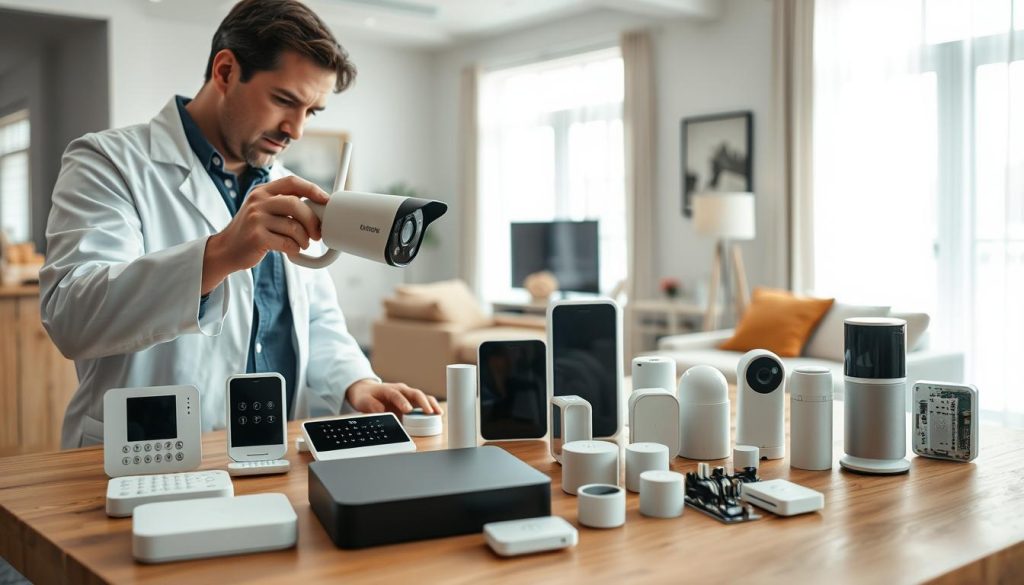
Hands-on, apples-to-apples testing in a two-story home
We bought and installed each package ourselves so you get honest, practical results. The crew timed setup, tracked app stability, and logged false alarms. We also measured camera clarity, night vision, and doorbell latency at the front door.
Weighted criteria: affordability, equipment quality/options, monitoring effectiveness
Scoring favored affordability (40%), equipment quality/options (30%), and monitoring effectiveness/self-monitoring features (30%). Our managing editor led reviews alongside two security expert reviewers and former patrol officers.
- What you gain: verified workflows such as text-first alerts, two-way deterrence, and video verification rates.
- We checked hub backups (battery, cellular) and how easy it is to change contract-free plans.
- More than 10,000 research hours and 60+ system reviews inform our SecureScores and practical ratings.
| Metric | Weight | What we tested |
|---|---|---|
| Affordability | 40% | Starter cost, expandability |
| Equipment quality | 30% | Camera clarity, sensors, night view |
| Monitoring | 30% | Alerts, verification, response tools |
Price Breakdown: Upfront Equipment and Truly Optional Monthly Costs
Start by separating equipment cost from optional services so you can budget clearly for what you own versus what you might add later.
Typical starter kit costs and financing options
Starter kits commonly range from about $159 to $269 for basic hub-and-sensor bundles. SimpliSafe starts near $250, Abode around $159–$179, and ADT Self Setup near $269. Ring kits vary widely ($199–$600). Reolink and Eufy camera kits sit near $160–$200.
Many retailers offer financing so you can pay monthly for gear through vendors like Affirm or Bread. That keeps equipment affordable while leaving monthly monitoring optional.
| Brand | Starter Cost (approx.) | Monitoring |
|---|---|---|
| SimpliSafe | $250 | Optional per month |
| Abode | $159–$179 | Optional per month |
| ADT Self Setup | $269 | Optional per month |
| Reolink / Eufy | $160–$200 | Local-first, add-ons |
When cloud storage is worth paying for
Cloud storage adds longer history, multi-camera clip syncing, and richer AI features. Choose it if you need extended event review or advanced detection. Otherwise, local storage on Reolink and Eufy hubs avoids monthly costs and keeps footage private.
- You’ll see typical kit prices so you know upfront hardware vs optional services.
- Plan costs per month vary by brand; you can avoid them if you self-monitor and use local storage.
- Cloud storage is worth it for long archives, multi-camera verification, or smarter alerts.
Tip: Compare total cost of ownership over two years to weigh a cloud-first plan against a local-first approach. That helps you balance affordability and responsiveness for your home security.
Self-Monitoring vs Professional Monitoring: What You Should Choose
Decide how hands-on you want to be before picking a plan. Self-monitoring sends instant app alerts and live video to your phone. Professional plans add verification and a team that can call or dispatch on your behalf.
Response workflows: texts, calls, and video verification
Text-first workflows speed decisions. ADT’s SMART Monitoring texts in roughly 10 seconds and can escalate faster than a voice-only call.
Agent-driven verification — such as SimpliSafe’s Intruder Intervention and Active Guard — lets staff speak through cameras and confirm emergencies before police are notified.
Peace of mind when you’re busy or traveling
Professional monitoring is ideal if you travel often or miss alerts during work. Video verification reduces false alarms and helps first responders prioritize real events.
- You get instant alerts with self-monitoring, but you must act on each one.
- Professional monitoring offers agent verification and dispatch when you’re unavailable.
- Hybrid setups let you self-monitor day-to-day and enable a monitoring service only during trips or high-risk periods.
| Option | Speed | When it helps |
|---|---|---|
| Self-monitoring | Immediate app alert | Hands-on users, tight budgets |
| Professional monitoring | Text/call + agent action | Travelers, busy households |
| Hybrid | Flexible | Seasonal risk, vacations |
Choose the model that fits your schedule, risk tolerance, and how much you want to rely on trained agents for your home security.
Smart Home Compatibility: Alexa, Google, and Apple HomeKit
A smart-home setup that plays well with your voice assistant makes everyday security smoother. Pick a hub that matches your main ecosystem so devices talk to each other without extras or glitches.
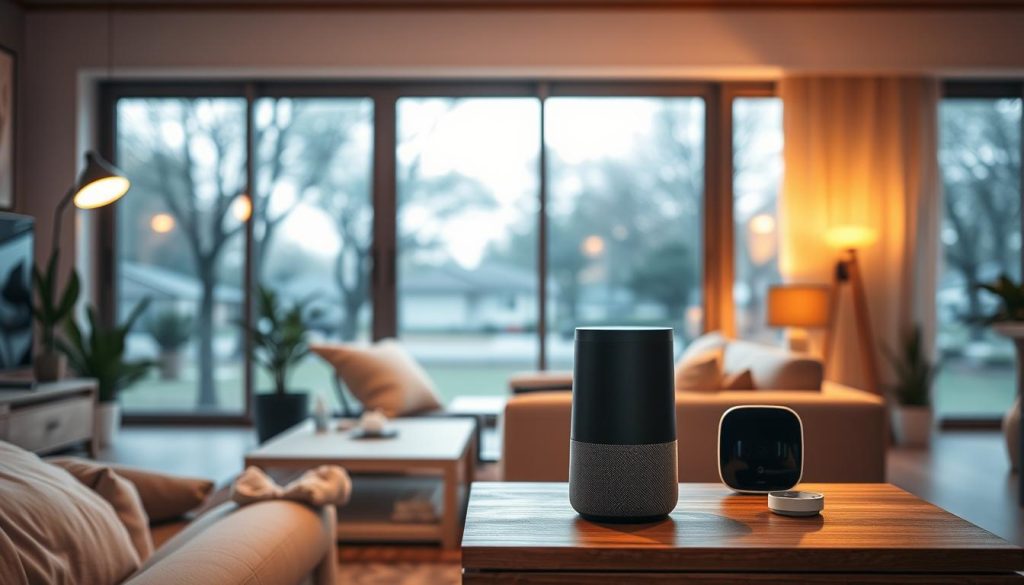
Practical picks: Abode supports apple homekit, Alexa, Google, Zigbee, and Z‑Wave, so it fits Apple-first households cleanly. ADT Self Setup pairs well with google home and Nest cameras for unified alerts. Ring aligns closest to Alexa and smart displays for quick video checks.
- Use routines to arm at bedtime, flash lights on alarms, or lock doors as you leave.
- Abode’s CUE enables chained home automation across sensors and third-party devices on paid tiers.
- Mix smart lighting and motion triggers to deter unwanted visitors before they reach entry points.
| Platform | Main Integrations | Ideal For |
|---|---|---|
| Abode | Apple HomeKit, Alexa, Google, Zigbee, Z‑Wave | Apple users and deep automations |
| ADT Self Setup | Google Nest, Google Home | Google-centric video and alerts |
| Ring | Alexa, Echo Show | Voice-first doorbell and display use |
Tip: Align your security system hub to your existing devices. That reduces duplicate gear, unlocks useful smart home features, and makes your setup easier to manage.
Security Cameras and Video Storage: Cloud vs Local
Deciding where your footage lives shapes cost, privacy, and what alerts you actually get.
If you want to avoid monthly bills and keep footage under your control, local storage-first options like Reolink and Eufy are ideal.
Who benefits from local storage-first
Local hubs record on-site and often run on-device AI to flag people, vehicles, or packages. That reduces false triggers and keeps recordings private.
Reolink and Eufy emphasize base stations that store clips locally and keep recording during brief internet outages.
Subscription perks: long history and verification
Cloud storage on platforms such as SimpliSafe, Ring, Arlo, and ADT/Nest gives longer archives and advanced analytics.
Paid plans also enable video verification so monitoring centers can confirm events faster and share clips quickly.
- Use an indoor camera near entries for face ID when alarms trigger.
- Outdoor cameras with spotlights boost night clarity and deter trespassers.
- Local storage = privacy and no monthly cost; cloud storage = longer history and smarter alerts.
| Option | Strength | When to pick |
|---|---|---|
| Local hub | Privacy, no monthly cost | You review footage rarely and want control |
| Cloud plan | Extended history, analytics | You need long archives or verification |
| Hybrid | Local backup + cloud perks | You want resilience and advanced alerts |
Core Sensors and Add-Ons You’ll Actually Use
Start by choosing sensors that cover likely entry points and high-traffic rooms. That keeps false alerts down and makes your setup useful from day one.
Entry sensors, motion sensors, sirens, and video doorbells
Entry sensors are usually peel-and-stick devices for doors and windows. Put them on the front door and key first-floor windows to stop common intrusion paths.
Motion sensor placement matters. A PIR motion sensor in a central hallway or large room catches movement if a door is bypassed.
Sirens act fast. Many hubs include built-in sirens, and separate units boost deterrence right away.
A video doorbell records porch activity and shows who is at the front door, which helps for deliveries and verification.
Life-safety add-ons and where brands differ
Round out protection with smoke, CO, and water-leak sensors for real safety beyond break-ins. SimpliSafe and Abode sell a wide set of environmental sensors.
Arlo’s All-in-One Sensor reduces clutter by tracking motion, light, temp, leak, and door/window status in one device. Ring and Nest remain strong choices for doorbell cameras.
- Start: entry sensors on the front door and main windows.
- Add: a motion sensor in halls or big rooms.
- Use a loud siren to deter intruders immediately.
- Install a video doorbell at your most-used entry.
- Include smoke, CO, and water-leak sensors for full safety.
- Place sensors where they have a clear line-of-sight and away from heat sources.
- Balance device count so app alerts stay manageable.
| Component | Common Role | Brands to Consider |
|---|---|---|
| Entry sensors | Protect doors/windows, early alert | SimpliSafe, Abode, Reolink |
| Motion sensor | Detect movement in halls/rooms | Arlo, Eufy, SimpliSafe |
| Video doorbell | Porch awareness and recording | Ring, Nest, Arlo |
| Life-safety sensors | Smoke, CO, water leak detection | SimpliSafe, Abode, Reolink |
Tip: Start small, test placements, then add devices as you learn your routines. That approach keeps your home security practical and tailored to how you live.
DIY Installation and Setup: What to Expect
Setting up a DIY kit usually takes under an hour, and most brands guide you step-by-step in their mobile app.
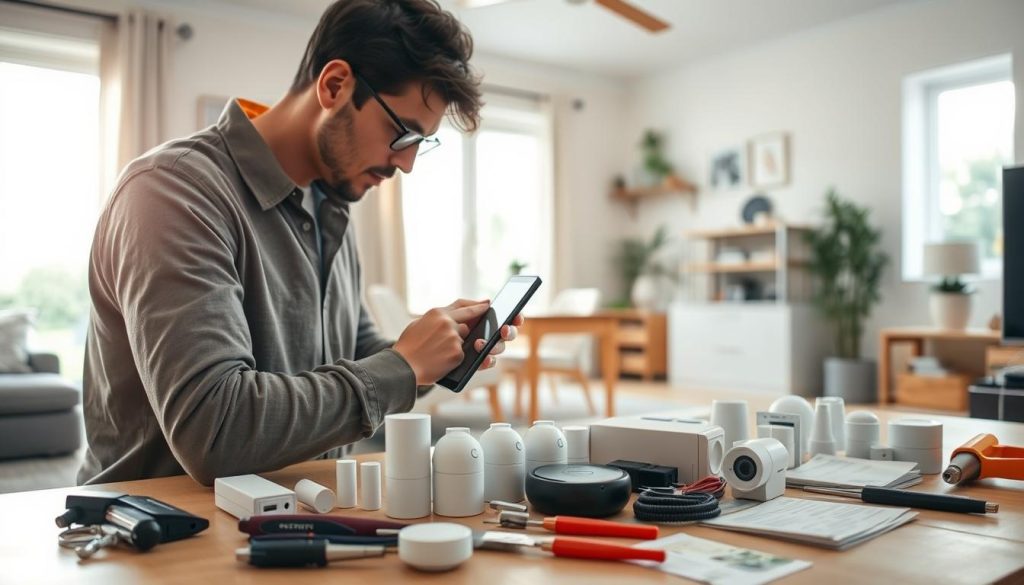
Average times and tools: Starter kits normally install in 30–60 minutes. Ring notes about a 30-minute install. Reolink often finishes under 30 minutes for cameras and hubs. ADT Self Setup, SimpliSafe, and Abode include app walkthroughs.
Average setup times and tools needed
- Expect a 30–60 minute install for starter kits; cameras and doorbells may add more time.
- DIY smart gear usually needs no special tools; a screwdriver or drill helps for mounts.
- Use the mobile app to name rooms and test each sensor during setup.
Common placement tips for better detection
- Make sure to clean surfaces before sticking sensors so they remain secure.
- Place motion sensors 6–8 feet high and angle them across doorways for better coverage.
- Keep the hub central and avoid metal or electronics that block signals.
- Test sirens and notifications so you hear alerts where you spend time.
| Task | Approx. Time | Why it matters |
|---|---|---|
| Starter kit install | 30–60 min | Quick activation, app tests sensors |
| Camera/doorbell mount | 30–45 min | Check Wi‑Fi strength at mount |
| Final test | 10–15 min | Confirm alerts and sirens work |
Tip: Start with essential sensors, label spares, and expand after a week of real use for the best diy experience.
Who Should Choose a No-Subscription Security System
Choose a kit that lets you own the gear and enable paid monitoring only when needed. A setup without subscription works well if you value privacy, low recurring cost, and control over recordings.
Consider this approach if you:
- Are budget-minded and prefer local storage plus app alerts to avoid ongoing charges.
- Live in an apartment or small house and need a light, portable setup you can take when you move.
- Are comfortable handling alerts on your phone instead of relying on a call center.
- Travel sometimes and plan to add professional monitoring only for trips or busy seasons.
- Prefer storing video at home for privacy rather than keeping all footage in the cloud.
- Want gear that pairs with your existing smart devices without paying for automation you won’t use.
Quick caution: make sure you can respond to alerts regularly. Self-monitoring beats having no system at all, but it requires time and attention.
| Your profile | Why it fits | Suggested focus |
|---|---|---|
| Cost-conscious renter | Low upfront, no monthly commitments | Entry sensors + video doorbell |
| Privacy-first homeowner | Local archives, on-device AI | Local-storage cameras + hub |
| Frequent traveler | Enable monitoring only during trips | Camera awareness + short-term monitoring |
If these points match your needs, a no-subscription route gives you control over features and long-term costs while still letting you add professional help when it matters most.
How to Pick the Right System for Your Home and Budget
Begin with a quick sketch of your layout so you know where sensors and cameras help most.
Map your home, list features, and plan expansion. Mark doors, ground‑floor windows, and the main hallway. That shows how many entry sensors, motion detectors, and cameras you actually need.
Decide if you are camera‑first or sensor‑first. Camera-focused brands like Arlo, Reolink, and Eufy often offer local storage to cut recurring costs. Sensor-led kits from SimpliSafe, Abode, Ring, and ADT Self Setup let you scale devices and monitoring easily.
Make sure the provider lets you change monitoring options month to month. Pick systems that support a self-monitoring plan now and let you add short-term professional monitoring when you travel.
- Prioritize a hub that supports your smart home and voice assistant for smooth home automation.
- Choose one security hub you can expand rather than swapping platforms later.
- Balance upfront savings against must-haves like battery/cellular backup and video verification.
| Brand | Monitoring flexibility | Best fit |
|---|---|---|
| SimpliSafe | Month-to-month add/remove | DIY alarm + optional agent help |
| Abode | Flexible plans, deep automations | Smart home integrations |
| Arlo / Reolink / Eufy | Local-first recording, optional plans | Camera-led setups, low monthly cost |
Budget for future add-ons like doorbell cams, floodlights, and environmental sensors. Watch sale events to bundle gear affordably. This approach keeps your plan flexible and suited to how you live and travel.
Conclusion
Choose one solid hub, cover main entry points, and expand cameras as your needs change. Our top picks help you start cheap and scale up: SimpliSafe for flexibility, Abode for smart integrations, and Ring Alarm for camera choice. ADT Self Setup adds quick, text-first escalation when you want pro help.
Arlo, Reolink, and Eufy shine for local storage and high-quality video that keeps ongoing costs low. Use the mobile app to tune motion zones and notifications so you only get meaningful alerts.
Compare each monitoring plan per month, click to view packages, and check amazon links for kit deals and doorbell bundles. Lean on our security expert testing to pick one security foundation that fits your routine and budget.
